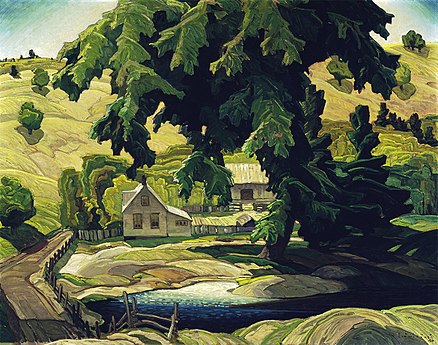
Franklin Carmichael, born in Orillia, Ontario, in 1890, is often described as the "quiet powerhouse" of the Group of Seven, a founding member who brought a unique vision and sensitivity to Canadian landscape painting. His journey from a carriage-maker’s son to a celebrated artist and educator reflects a deep commitment to both his craft and the Canadian landscape that he so vividly depicted in his works.
Early Life and Education
Carmichael was the son of Scottish immigrants who settled in Orillia in the late 1880s. Growing up, he worked alongside his father, a skilled carriage maker, and it was here that Carmichael received his initial training in design. His artistic talents were further nurtured through lessons with Canon Greene, a local artist who may have inspired characters in Stephen Leacock's Sunshine Sketches of a Little Town. In 1909, Carmichael crossed paths with William Wood, a fellow aspiring artist, and their friendship fueled Carmichael’s determination to pursue a career in art.
When his father sold the family business in 1911, Carmichael seized the opportunity to move to Toronto, where he enrolled in the Ontario College of Art. There, he studied under William Cruikshank and G.A. Reid, honing his skills in painting and design. He also studied under Gustav Hahn at the Toronto Central Technical School, which further shaped his approach to art.
Early Career and Formation of the Group of Seven
In 1911, Carmichael began working as an apprentice at Grip Engraving, a Toronto firm known for its innovative design work. It was at Grip that Carmichael met several artists who would become lifelong friends and collaborators, including Tom Thomson, Arthur Lismer, J.E.H. MacDonald, and Fred Varley. These friendships led to weekend sketching trips that would become the foundation for the Group of Seven.
In 1913, Carmichael traveled to Antwerp, Belgium, to study at l'Académie des Beaux-Arts under Isidor Apsomer and G. Van Der Veken. His studies were a resounding success, earning him the highest award for Drawing from Life. Upon returning to Toronto in 1914, Carmichael shared living quarters with Thomson in a shack behind the Studio Building, where the two artists immersed themselves in their work.
Carmichael’s marriage to Ada Went, a childhood sweetheart from Orillia, marked a new chapter in his life. To support his growing family, he took a steady job at Rous & Mann, a commercial art firm, but continued to paint whenever time allowed. By 1920, Carmichael had joined the ranks of the Group of Seven, officially formed that year. The group sought to capture the spirit of the Canadian wilderness, and Carmichael’s contributions were marked by his delicate use of color and light, particularly in his watercolors.
Exploration and Mastery
Carmichael’s work often took him to the remote corners of Ontario, where he found inspiration in the rugged landscapes of the North. In 1924, he made his first sketching trip to the north shore of Lake Superior with Lawren Harris. This journey, and subsequent trips with fellow Group of Seven members, fueled some of his most iconic works, such as October Gold (1922) and A Northern Silver Mine (1930), both now part of the McMichael Canadian Art Collection.
While Carmichael initially worked in oils, by 1925 he had shifted his focus to watercolors, co-founding the Canadian Society of Painters in Water Colour with A.J. Casson and Fred Brigden. His watercolors were praised for their bold, untraditional approach, which brought a fresh perspective to Canadian landscape art. He also made significant contributions to graphic design, working on wood engravings and illustrating books such as Grace Campbell’s Thorn-Apple Tree (1942).

Later Years and Legacy
In 1932, Carmichael left Sampson-Matthews, where he had worked since 1925, to become the Head of the Graphic Commercial Art Department at the Ontario College of Art (OCA). His influence as an educator was profound, as he devoted himself to developing programs for students and veterans returning from World War II.
Carmichael’s deep love for music was another defining aspect of his life. He played the bassoon, cello, and flute, and participated in orchestral performances, balancing his musical and artistic pursuits with remarkable dedication.
On October 24, 1945, after a typical day at OCA, Carmichael tragically passed away at the age of 55, succumbing to a heart attack while driving home. He left behind a rich legacy as a painter, designer, and educator. His work is celebrated in numerous public collections, including the Art Gallery of Ontario, the McMichael Canadian Art Collection, and the National Gallery of Canada.
Franklin Carmichael's contributions to Canadian art were celebrated in memorial exhibitions, including a significant show at the Art Gallery of Ontario in 1947. His work continues to be admired for its quiet power, capturing the essence of the Canadian landscape with a sensitivity and grace that remains unparalleled. Carmichael’s legacy is not just in his paintings, but in his profound influence on the next generation of Canadian artists.
Browse our collection of Canadian paintings for sale at the Canadian Classic Fine Art gallery, The best place to buy a painting online. We provide free shipping anywhere in Canada and the United States. Our Montreal art gallery sells paintings online exclusively and have a 14 days return policy.
